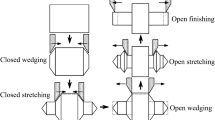Abstract
Aiming at the concavity defects in the cross-wedge rolling (CWR) process, one new rolling method named as the twice closed–open joint CWR was presented to improve the use ratio of material in CWR of the axle parts. The new rolling method included three stages: the first closed rolling, the second closed rolling and the last open rolling. To investigate the flow of material in this rolling process, one 3D finite element model (FEM) of the twice closed–open joint CWR was established. The CWR process of one pump spindle part was simulated using the established 3D FEM. The formation, the flow law of metal materials and concavity defects of end were studied. In addition, the CWR experiments were carried out. The results of simulation agreed with the results of tests well. The results proved that the new method can decrease the extent of concavity and improve the material use ratio.













Similar content being viewed by others
References
Dong Y, Tagavi KA, Lovell M R, and Deng Z, Int J Mech Sci42 (2000) 1233.
Li Q, Lovell M R, Slaughter W, and Tagavi K, J Mater Process Technol125–126 (2002) 248.
Urankar S, Lovell M, Morrow C, Li Q, and Kawada K, J Mater Process Technol177 (2006) 545.
Zhou J, Xiao C, Yu Y, and Jia Z, Int J Adv Manuf Technol65 (2013) 745.
Lee H W, Lee G A, Yoon D J, Choi S, and Na KH, J Mater Process Technol201 (2008) 112.
Wang M, Xiang D, Xiao C, Zhou J, and Jia Z, Int J Adv Manuf Technol59 (2012) 473.
Wei Y, Shu X, Han S, Tian D, and Wei J, Int J Adv Manuf Technol95 (2018) 1975.
Sun S H, Xiong Y, Zhao J, Lv Z Q, and Li Y, Scr Mater53 (2005) 137.
Zhou J, Yu Y, and Zeng Q, Int J Adv Manuf Technol72 (2014) 1559.
Wu H B, and Guo L, Adv Manuf Process29 (2014) 1441.
Lee R S, and Jou J L, J Mater Process Technol140 (2003) 43.
Shivpuri R, and Eruç E, Int J Mach Tools Manuf33 (1993) 153.
Pater Z, J Mater Process Technol173 (2006) 201.
Bartnicki J, and Pater Z, J Mater Process Technol164–165 (2005) 1154.
Wang M, Li X, Du F, and Zheng Y, Mater Sci Eng A391 (2005) 305.
Çakırcalı M, Kılıçaslan C, Güden M, Kıranlı E, and Shchukin V Y, Int J Adv Manuf Technol65 (2013) 1273.
Yang C, Zheng Z, and Hu Z, Int J Adv Manuf Technol95 (2017) 1.
Huang X, Wang B, Zhou J, Ji H, and Mu Y, Int J Adv Manuf Technol92 (2017) 1.
Ji H, Liu J, Wang B, Zhang Z, and Zhang T, J Mater Process Technol221 (2015) 233.
Wei B, Wang P, Liu W, Yang M, and Jiang L, Int J Non-Linear Mech83 (2016) 65.
Lin Z C, and Lee S Y, J Mater Process Technol70 (1997) 47.
Zeng J, Xu C, Ren W, and Li P, Int J Adv Manuf Technol91 (2016) 1.
Markov O E, Perig A V, Zlygoriev V N, Markova M A, and Grin A G, Int J Adv Manuf Technol90 (2016) 1.
Pater Z, Weroñski W, Kazanecki J, and Gontarz A, J Mater Process Technol92–93 (1999) 458.
Yan H J, Liu J P, Hu Z H, Wang L J, and Liu Y Z, J Cent South Univ43 (2012) 2114.
Chumachenko E N, Logashina I V, and Aksenov S A, Metallurgist50 (2006) 413.
Author information
Authors and Affiliations
Corresponding author
Additional information
Publisher's Note
Springer Nature remains neutral with regard to jurisdictional claims in published maps and institutional affiliations.
Rights and permissions
About this article
Cite this article
Pei, L., Liu, C. & Shu, X. Study on Formation Mechanism of Axle Part in the New Cross-Wedge Rolling Process Based on Experiment and Simulation. Trans Indian Inst Met 72, 3305–3312 (2019). https://doi.org/10.1007/s12666-019-01800-2
Received:
Accepted:
Published:
Issue Date:
DOI: https://doi.org/10.1007/s12666-019-01800-2



